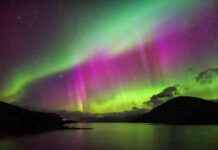People in the UK were treated to a spectacular show on Thursday night as the Northern Lights, also known as aurora borealis, lit up the sky with a beautiful display of green and pink hues. While it is more common to see the Northern Lights in parts of Scotland and the north, it is rare for the phenomenon to be so clearly visible across England.
What causes the Northern Lights to be visible in the UK? Aurora displays happen when charged particles from the sun collide with gases in the Earth’s atmosphere near the magnetic poles. This collision produces light at different wavelengths, creating the colorful spectacle that we see in the sky. Although the Northern Lights are typically seen in high polar latitudes, they can sometimes extend southward to be visible in parts of the UK, especially during geomagnetic storms originating from solar activity.
According to a spokesperson from the Met Office, there have been more space weather events, including the Northern Lights, in recent months because the sun is approaching the peak of its solar cycle. The sun operates on a cycle of about 11 years, with peak sunspot activity known as solar maximum. Sunspots can lead to Earth-directed releases of energy called coronal mass ejections, which in turn can result in visible auroras.
The stunning display of the Northern Lights on Thursday was caused by a severe solar storm triggered by a strong flare. The National Oceanic and Atmospheric Administration in the USA issued a warning of a severe geomagnetic storm due to a coronal mass ejection, resulting in G4 (Severe) levels of geomagnetic storm activity.
The Met Office spokesperson mentioned that there was a possibility of seeing auroras in parts of the UK on Thursday night and into Friday morning. He advised that the best chances of witnessing the Northern Lights were in Scotland and Northern Ireland, with a slight possibility of sightings in the north of England and even further south. Additionally, those in the Midlands could potentially capture the auroras with a camera equipped with long exposure settings.
As we are nearing the peak of the solar cycle, more space weather events, including the Northern Lights, are expected in the coming months. International prediction centers, such as the Met Office Space Weather Operations Centre, anticipate the solar maximum to occur later this year or early next year.
Overall, the recent display of the Northern Lights across the UK was a rare and mesmerizing sight, showcasing the beauty of nature’s light show in the night sky.



